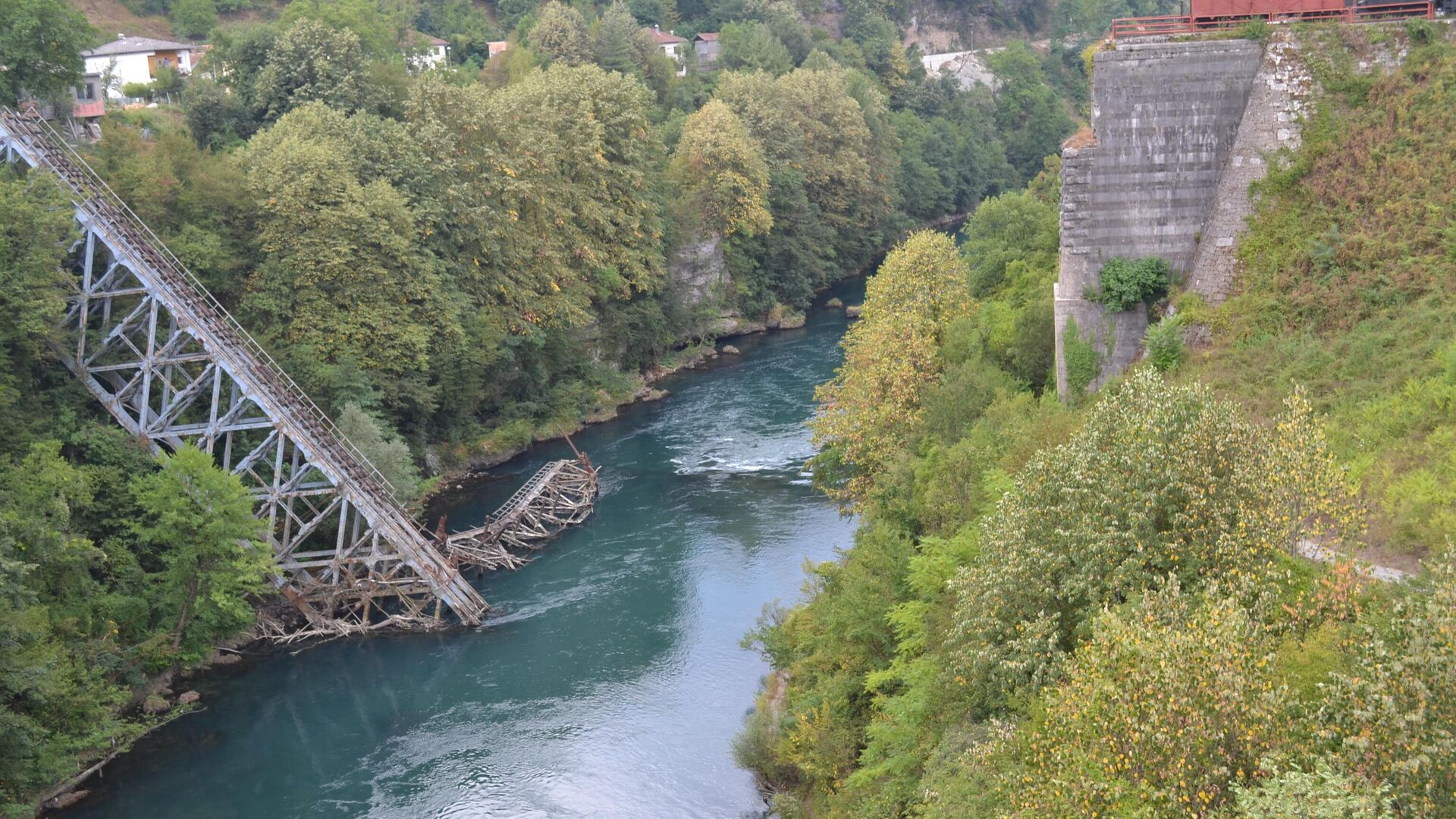‘Tiger in a Cage’: 80 Years Since Yugoslav Partisan Leader Tito Smashed Nazi Forces on Neretva River
Subscribe
Nowhere was the irregular anti-Nazi resistance more dogged or successful than in mountainous Yugoslavia, where Josip Broz Tito led a partisan army in a yearslong cat-and-mouse chase against Germans, Italians, and their Četnik and Ustaše Yugoslav collaborators.
While the Nazi war machine advanced quickly across much of Central and Eastern Europe, in many places their presence was constantly challenged by resistance groups and guerrilla fighters. Their constant harassment of the supply lines of the Germans and their allies was a significant drain on their front-line forces fighting in the Soviet Union and elsewhere, as it required hundreds of thousands of troops to be diverted to deal with the insurgents.
The steady collapse of the German and Italian position in North Africa in 1942, following a British counterattack in Egypt and American amphibious landings in Algeria, raised Axis fears of an Allied landing in the Balkans - a maneuver favored by British Prime Minister Winston Churchill - in the underbelly of Nazi-occupied Europe. Yugoslavia was vulnerable for several reasons, including the persistence of partisan forces such as the communist National Liberation Army (NLA) and the monarchist Četniks, the latter of whom were quietly playing both sides by fighting the NLA for the Nazis.
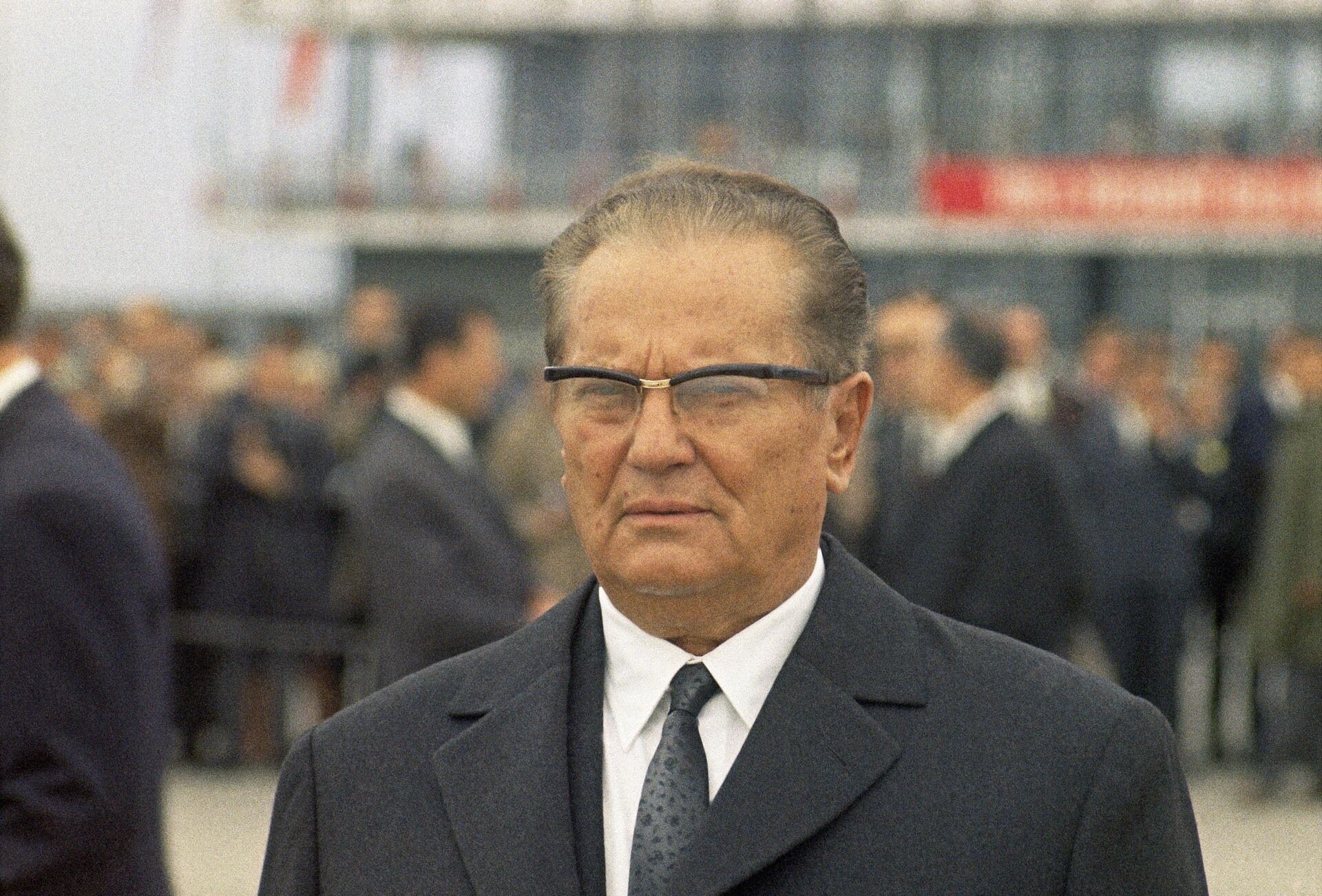
Close-up of President Josip Broz Tito of Yugoslavia, as he welcomes President Giuseppe Saragat of Italy at the Belgrade airport, Yugoslavia on Oct. 2, 1969, for the first state visit of an Italian President to neighboring Yugoslavia
© AP Photo / Giulio Broglio
As a result of this threat, German and Italian forces launched major campaigns to disrupt the NLA base in eastern Bosnia and Herzegovina. This was largely completed by late 1942, with the NLA Partisans being forced into the west, occupying a broad space of freed territory encompassing most of western Bosnia and southeastern Croatia. However, a massive new operation was being planned for early 1943 involving four German divisions, 90,000 men, including the crack 7th Waffen-SS Division, and a broad alliance of Italian, Četnik, and Ustaše forces.
Against them, Tito had barely 20,000 troops, and would lose half of them before the battle was over.
Axis Attack
“Pacifying” an area that had once supported partisans meant the executions of captured partisans, including the wounded, and the massacres of whole villages and towns that had supported them instead of the occupiers.
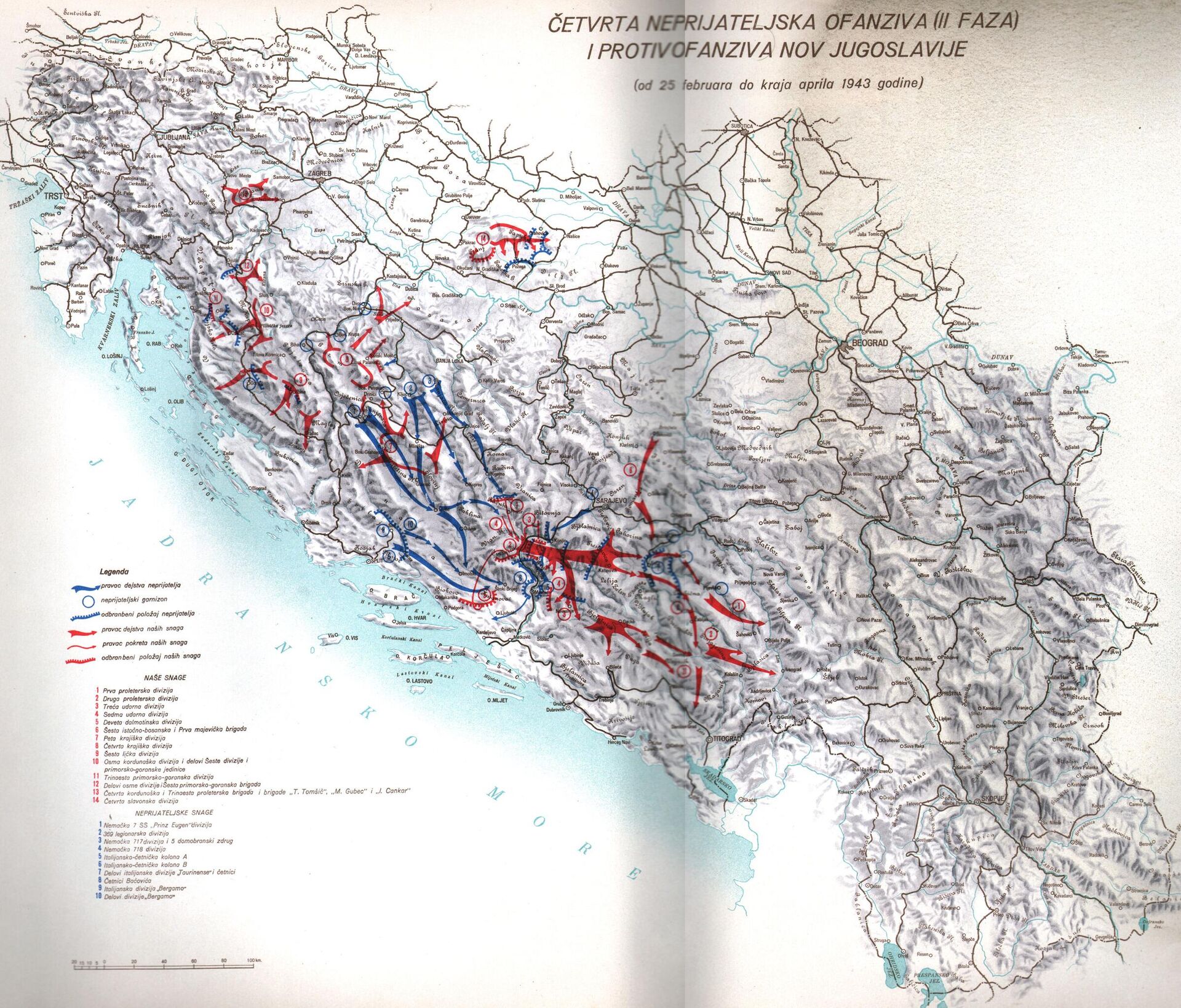
Map describing the Fourth Enemy Offensive (Operation Case White) and Partisan Counter Offensive (5 February to the end of April 1943)
Sensing the noose tightening, Tito decided to act and sought to break out eastward and return to their old raiding grounds in eastern Yugoslavia. When the German assault, codenamed Fall Weiss (Case White), began on January 20, 1943, the Partisans held the western line fiercely, but slowly retreated to the east.
By early March, the Partisans had lost half their territory in the west and were slowly being hemmed in, using their best forces to protect a massive field hospital in Šćit, on Ramsko Lake near Prozor. Along their eastern flank were Italian and Četnik forces in the steep valley formed by the Neretva River, which flows in an upside-down U-shape around the massive Prenj mountain.
Konjic, at the top of that “U” and defended by 3,000 Četniks, was the gateway to eastern Herzegovina and the Partisans’ best route of escape. A surprise Partisan attack on Konjic on February 22 failed, but the Partisans moved into other cities along the Neretva whose Italian garrisons had been exhausted by fighting, including the western banks of Jablanica and Mostar.
Three days later, the Axis forces launched a new phase of their operation, buttressed by new forces on all sides of the Partisans, including reinforced Italian and Četnik troops on the right bank of the Neretva. The Germans mistakenly assumed Tito’s headquarters lay almost 40 miles to the west in Livno, which was well-defended but strategically unimportant by then.
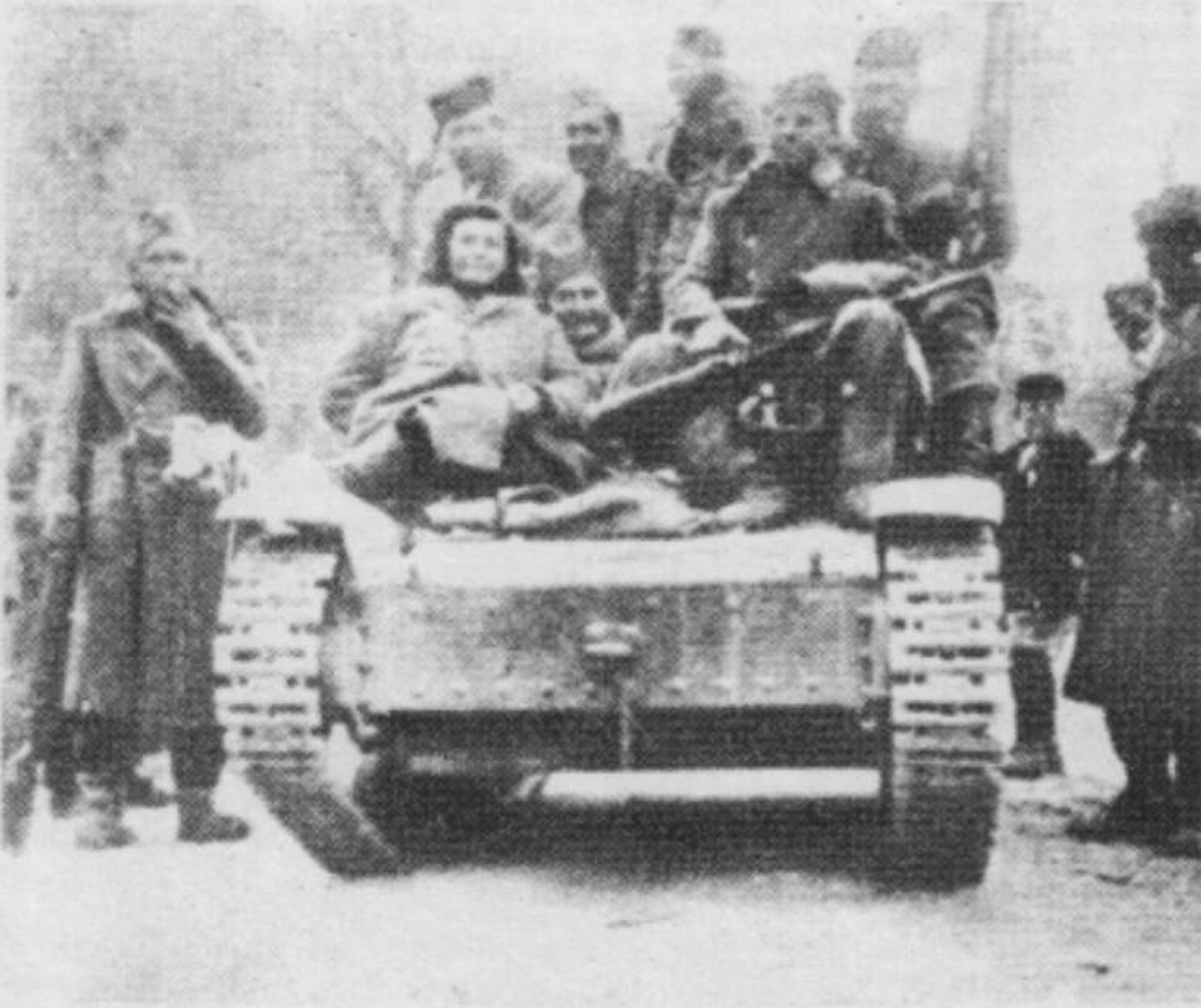
Yugoslav Partisans with a captured Italian tank in the Neretva valley, February 1943
The Partisans steadily gave way as the Germans advanced, withdrawing as civilians were evacuated and preserving their strength as they retreated towards the Neretva. However, with the field hospital in Šćit under threat and the noose tightening on all sides, Tito was forced to adopt a bolder strategy.
Escaping Checkmate
First, Tito had to protect the hospital by sending most of his forces northward, to Gornji Vakuf and Prozor to blunt an attack by the German “Vogel” battle group. To disguise this counteroffensive, Tito ordered all the bridges along the Neretva to be blown up. This would deceive the Axis forces into believing he intended to march northward, when instead all he was doing was buying time.
The counterattack against the Germans on February 28 was brutal, but worked. The battle happened in deep snow amid horrid weather conditions. Many soldiers suffered frostbite and other cold-related ailments.
However, to advance further north with so many German and Axis forces concentrated there would be suicide. Tito then turned his forces about-face, and most to the south again - a move absolutely nobody expected.
In his reminiscences on the subject, former Yugoslav deputy prime minister Milovan Djilas compared the Partisans’ situation to that of their Chinese comrades during the Long March.
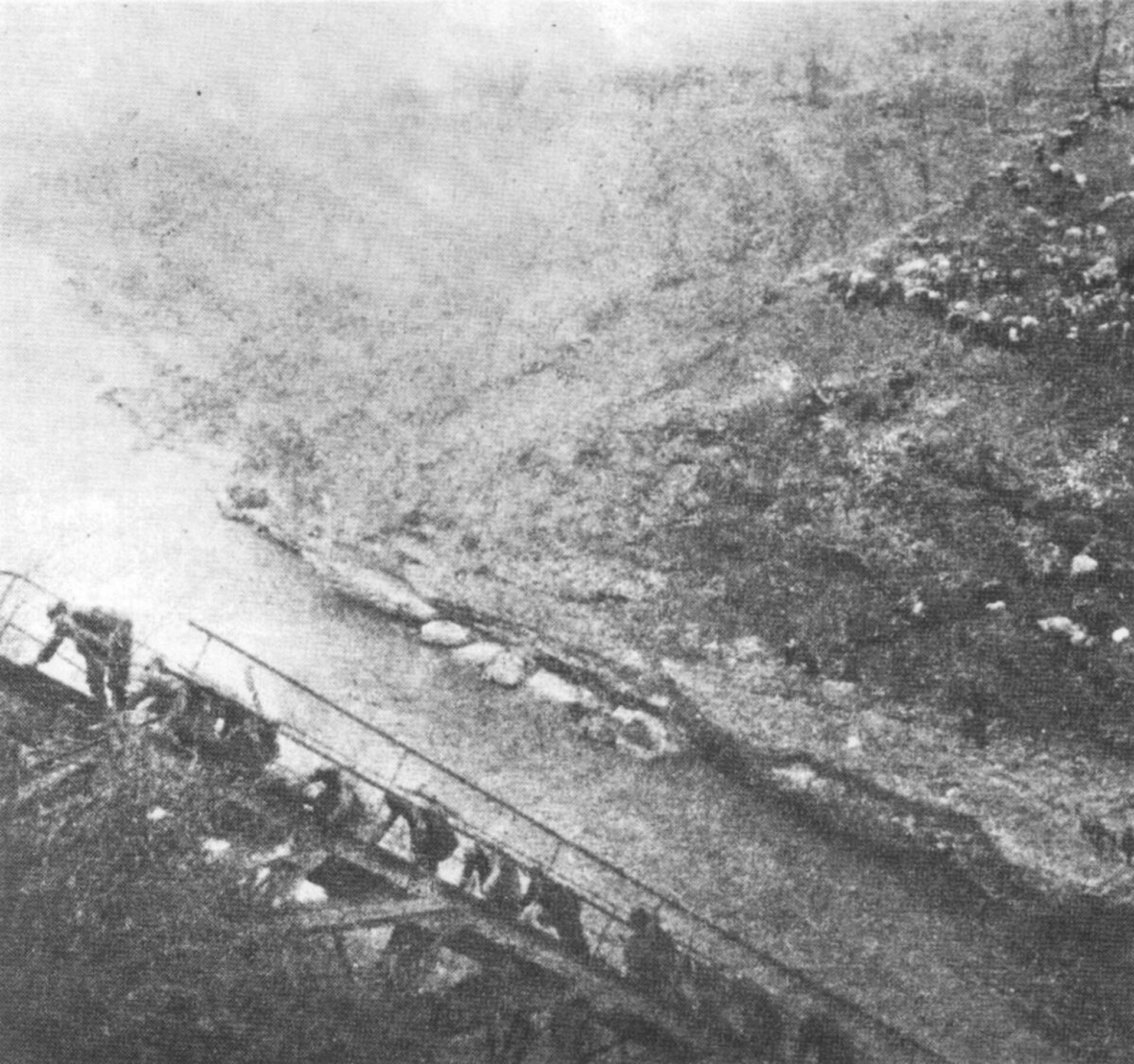
Yugoslav Partisans crossing the Neretva River over the construction of the broken bridge at Jablanica, March 1943.
"The enemy is around us on all sides...we are caught in the valley of the Rama. In front of us is the Neretva gorge. Our only choice is to follow goat paths like the Chinese partisans who crossed the Tata river in their Long March … Tito on the Neretva was a tiger in a cage, clawing about for weak spots - among the Italians and the Četniks, of course - gauging a hole wide enough for the partisan storm to gush through."
The southward attack began on March 5 in dramatic fashion: driving captured Italian tanks, the Partisans re-entered Jablanica and the Četniks, who assumed they were allied Italian forces, came out to meet them. The Partisans surprised them with gunfire and they scattered.
Their deception was just beginning. The following evening, March 6, Tito sent a crack unit called “thunder of the tenths” to sneak across the Neretva River and surprise the Četniks on the far side, too. They clamored across the skeleton of the destroyed bridge in Jablanica under cover of darkness, ambushing the Četniks and securing the far bridgehead.
The morning after, construction started on a new temporary bridge using the skeleton of the old one. In just 18 hours, they built a wooden bridge 56 meters long and 2.5 meters wide - just big enough to get their forces across.
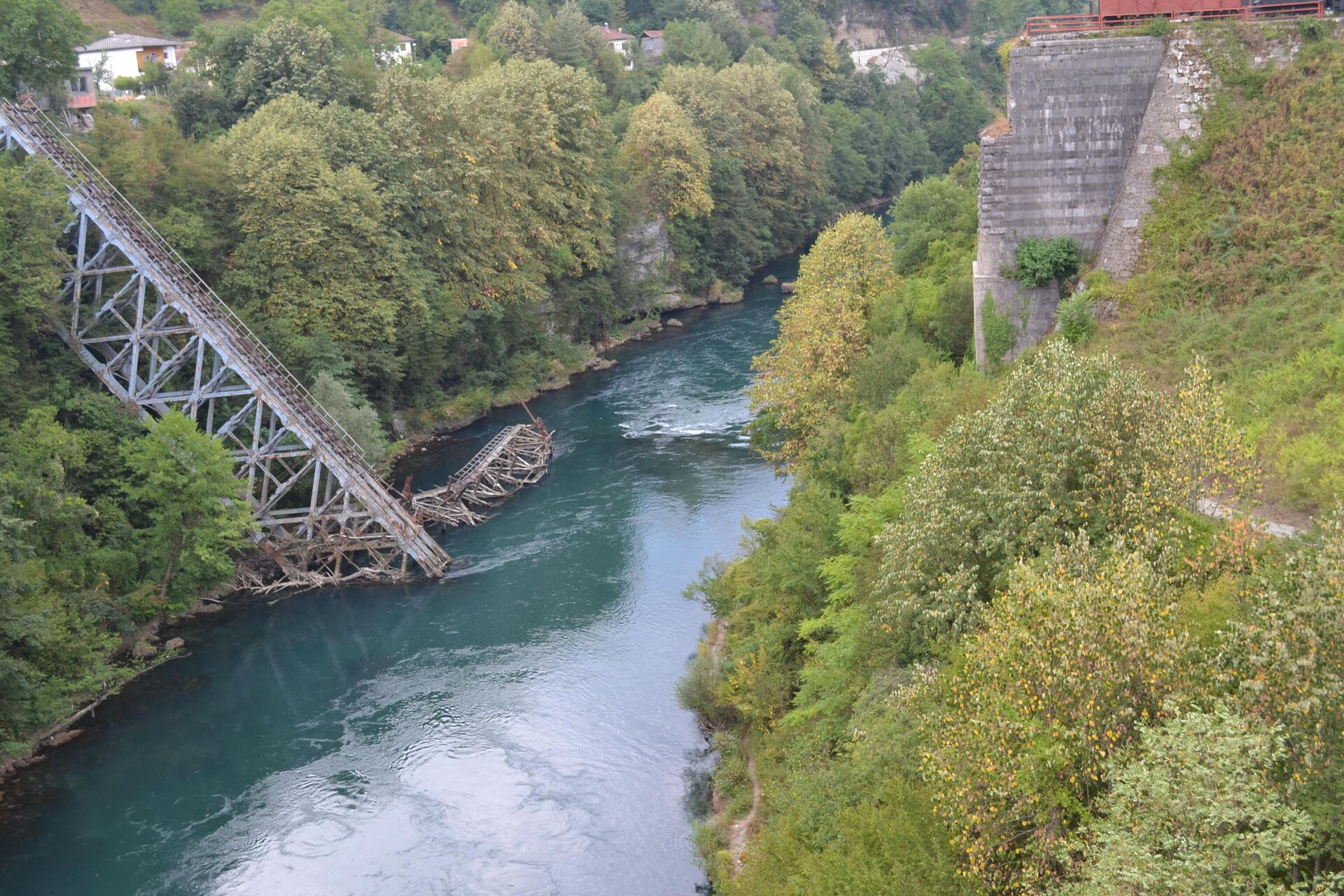
The wreck of the rail bridge over the Neretva River at Jablanica, Bosnia and Herzegovina. The bridge was rebuilt by the Nazis in August 1943, after Yugoslav Partisans under Tito destroyed it the previous March. It was then blown up again in 1968 during a film about the Partisan attack.
The complete surprise attack had folded the Četnik lines around Jablanica, creating a safe hole in the Axis lines, and the temporary bridge became a lifeline by which to evacuate the wounded from the field hospital - which is why the Battle of the Neretva is sometimes called Battle of the Wounded. Tito thus kept his word that he would never abandon his wounded men. The mountainous terrain helped protect the bridge from German air attack, and after his forces were across, Tito had that bridge blown up, too.
Četnik-held Konjic still blocked the road east, however, so again, Tito improvised: his troops abandoned their vehicles, dumping them in the river and proceeding across the mountains on foot, eventually escaping the Axis cauldron and establishing new operation in eastern Herzegovina and Montenegro, where the weakness of the Četniks provided them with space to regroup.
Although the battle is regarded as a tactical victory for the Axis powers, who killed large numbers of partisans and pacified a huge area of formerly-liberated territory, the Yugoslav Partisans survived and were able to continue their operations against the fascists, making it a major strategic victory.
As the Axis suffered serious losses on the Soviet front and began an almost permanent retreat, their ability to attack the Partisans collapsed as well, and the NLA re-established control over large swaths of the country by the time the Soviet Red Army entered Belgrade in October 1944.
